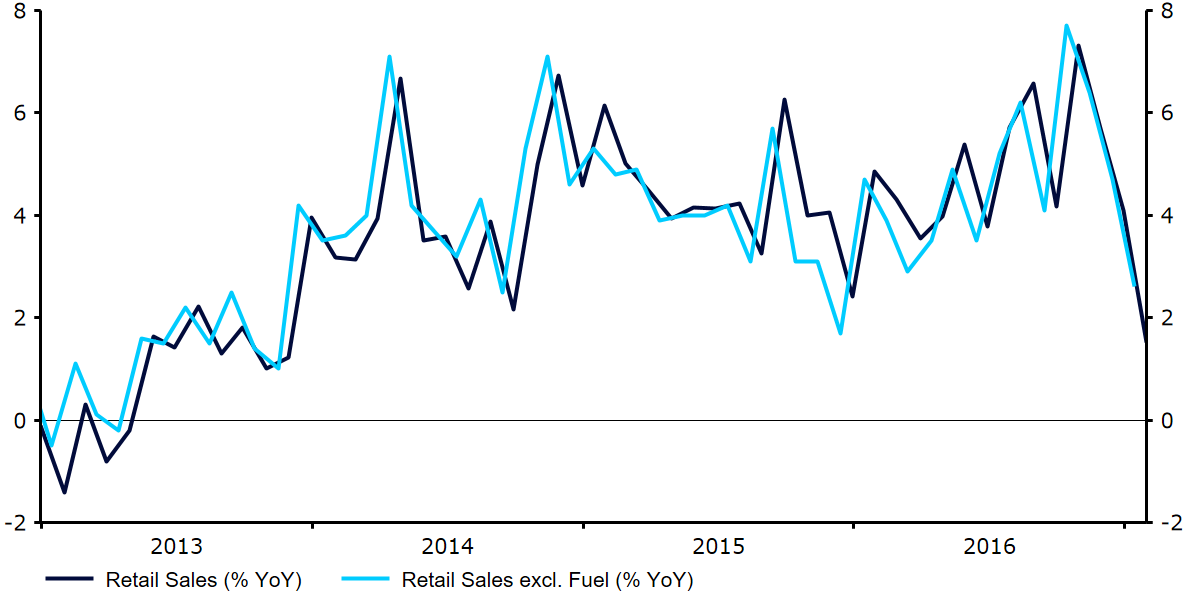Sterling slumps after weak retail sales, Euro rebounds from one month low
- Go back to blog home
- Latest
The Pound slipped by over half a percent against the US Dollar this morning after the release of a very weak set of retail sales figures dampened hopes of a stronger-than-expected recovery in the UK economy in the first quarter of the year.
Figure 1: UK Retail Sales (2013 – 2017)
Earlier on Thursday, the Euro recovered from its one month low, with falling US bond yields and dimming expectations for a March interest rate hike by the Federal Reserve sending the US Dollar lower across the board.
Yesterday’s move was not driven by any fundamental announcements, with some traders citing a flow-driven rally in which a large buyer in the market spooked a reversal in Euro short positions. Investors also dialled back bets on the Fed raising rates at next month’s FOMC meeting, despite some relatively hawkish comments from Chair of the Federal Reserve Janet Yellen earlier in the week. Implied probability for a March hike fell to 22% from 31% on Thursday.
The move was made all the more surprising given the minutes out of the European Central Bank’s January meeting continued the run of consistently dovish commentary out the ECB in recent weeks. The ECB reiterated the need to maintain a “steady hand” approach in order to reassure markets, while claiming it will continue to look through the current surge in inflation when deciding on its next monetary policy move.
Major currencies in detail
GBP
Sterling declined by 0.5% this morning after today’s weak retail sales figures, having spent much of yesterday range bound.
With Brexit news out of Britain fairly limited in the past couple of weeks the Pound has failed to break out of the 1.24-1.27 range in the past month. However, today’s very underwhelming set of retail sales figures could soar sentiment towards the currency and adds to a particularly poor few days of economic news out of the UK, with inflation and earnings also falling short of expectations.
Expectations that the Bank of England would rush into raising interest rates again following last August’s cut have taken a blow and it appears a normalisation in monetary policy in the UK remains a long way off.
Investors now await details on whether Theresa May will be able to follow through with her plan to trigger Article 50 before the end of March.
EUR
The single currency rallied 0.5% against the US Dollar yesterday, largely driven by uncertainty over the Fed’s plans for future interest rate hikes.
In tandem with yesterday’s fairly dovish set of ECB minutes, senior Bundesbank member Carl-Ludwig Thiele struck a similarly cautious tone yesterday. Thiele urged against a sudden increase in interest rates in Europe, suggesting that such an act would hurt bank profitability in the near term.
Construction output out this morning is unlikely to rock the boat. Attention will tentatively turn to next Tuesday’s inflation data.
USD
A fall in US bond yields and Fed rate hike chances caused the Dollar to end London trading 0.4% lower on Thursday.
Housing data out of the US yesterday was very positive, adding to the recent stream of solid news out of the world’s largest economy. Housing stats came in above expectations at 1.285 million units versus the 1.226 million consensus. Building permits also rose to their highest level in a year, with permits in the South hitting their highest level since July 2007.
Jobless claims figures also continued to impress. Claims last week rose modestly to 239,000, which remains around their lowest level in four decades.
With no significant economic data releases in the US today, investors will turn their attention to Wednesday evening’s FOMC minutes.


